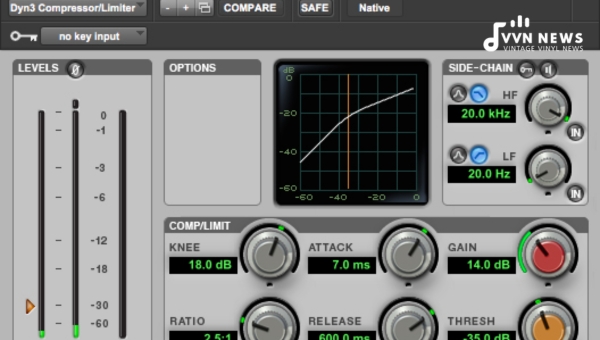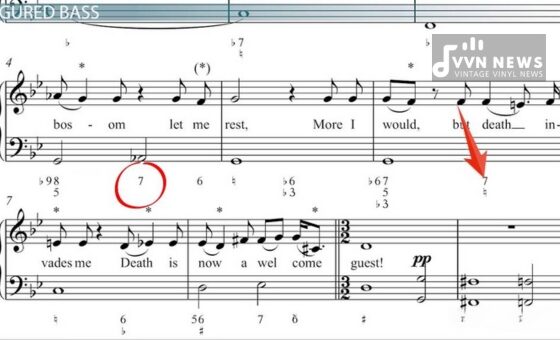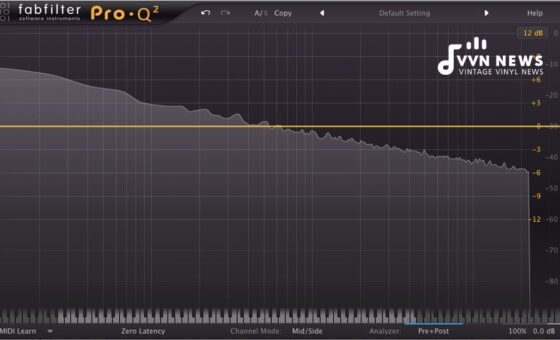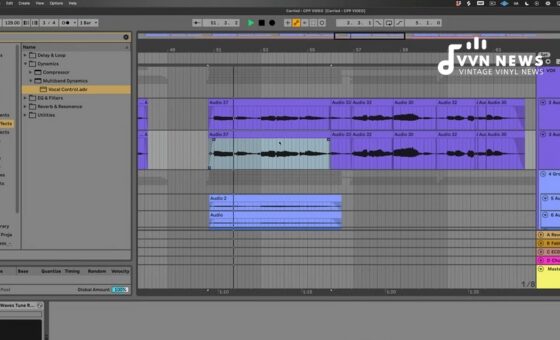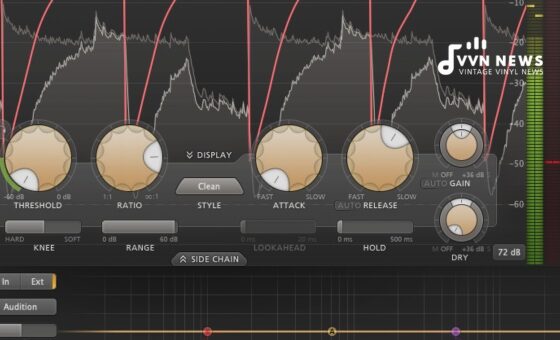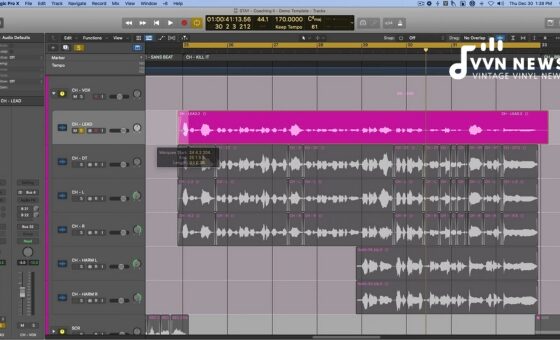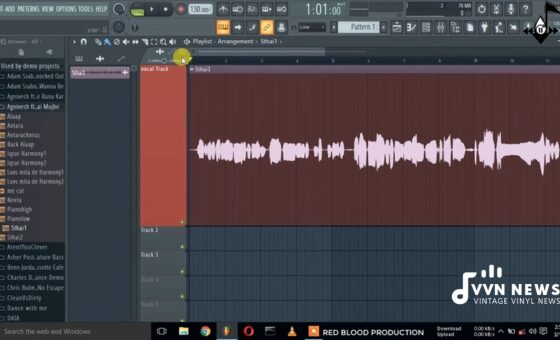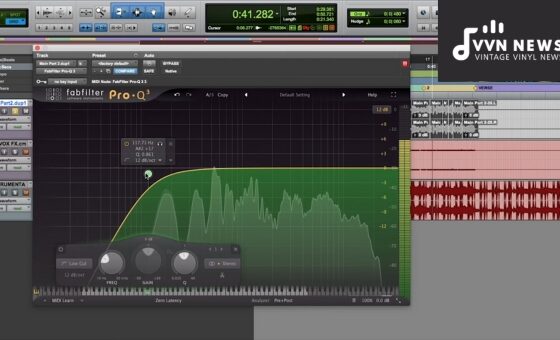In music production, the ‘bass compression’ concept often surfaces as an essential component.
It’s an incredible tool in music mixing, giving your tracks a definite edge and balance.
It’s no secret that navigating the intricate facets of bass compression can be daunting.
For amateurs and professionals alike, if you seek to enhance your understanding and application of this pivotal technique, you are on the right track.
Simply put, bass compression controls the dynamics to establish a consistent low-end sound that doesn’t overpower or get lost in the mix.
Effective use of this technique bridges the volume disparity between highs and lows and boosts your audio’s overall feel and timbre.
So, how do we execute this delicate balancing act? Let’s journey into this stimulating world together in the following sections.
What is Bass Compression?
Bass compression is a method applied in music production to manage the dynamic range of bass sounds. It allows producers to control volume levels, enhance sustain, and prevent distortion.
This is accomplished by reducing the volume of loud sounds and amplifying softer ones, ensuring a balanced and consistent bass tone.
Bass compression is typically utilized during the mixing phase of audio production using specialized hardware or software tools, commonly known as compressors.
The Significance of Bass Compression
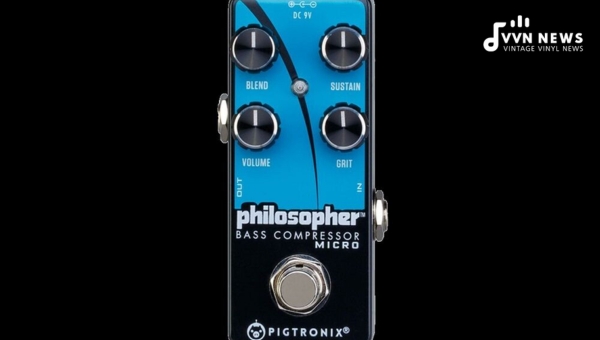
Comprehending the significance of bass compression starts with understanding the inherent qualities of bass instruments.
They produce low-frequency sounds that have longer wavelengths compared to higher-pitched tools.
This makes them more prone to fluctuations in volume or dynamics, mainly when performed live or recorded. Now, let’s dive deeper into why we need to control these dynamics.
Retains Consistency
Irregular peaks or troughs in a bass track can be jarring to an otherwise harmonious composition.
With a well-applied compression, you reduce dynamic range and maintain a consistent output. This doesn’t mean leveling everything flat but moderating the extremes for smoother plays.
Accentuates Groove
The rhythm and groove of your track directly relate to the pulse created by your bass line. Bass compression accentuates this pulse, bringing out a more apparent rhythmic feel.
Also Read: 27 Best Bass Songs [Experience The Deepest Grooves Of Music]
Enhances Timbre
An interesting facet is how bass compression enhances tone quality or timbre. Noteworthy is that it homogenizes the tone across harder and softer sections, maintaining tonal warmth and depth.
So, at its core, bass compression isn’t just about controlling dynamics; it’s an art form shaping your music’s overall feel and delivery.
Reasons to Utilize Bass Compression in a Track
Mastering the use of bass compression is instrumental in mold molding your track to perfection.
Here are some reasons why this tool is valuable and how it enhances your track.
Smoothing Out the Performance Dynamics
Whether recorded or live, a bassist’s performance tends to fluctuate.
These variations could be intensity from simply plucking a string harder or softer.
You can smooth out these inconsistencies by applying certain degrees of compression, making the bass tone more steady and manageable throughout the mix.
Enhancing the Rhythm Perception
Bass, by its very nature, sets the rhythm for any track. While every element contributes its part, undeniably, it’s the rhythm of a bassline that has our feet tapping.
The application of bass compression helps make the downbeats more noticeable without excessively elevating overall levels.
Consequently, it emphasizes rhythmic nuances subtly without overpowering other tone dynamics.
It widens the door for listeners to connect better with your tracks by augmenting the rhythm perception – a crucial musical aspect that resonates with people on an almost primal level.
Also Read: Best Bassists Of All Time [Feel The Rhythm With These Icons]
Enriching the Bass Tone
The application of bass compression is not limited to control or balance; it’s also about aesthetically enriching sounds.
When applied methodically and judiciously, reduction can enhance unique character traits of a bass sound that might otherwise get lost in the mix—creating what some enthusiasts often describe as “audible magic.”
In straightforward terms, moderate amounts of compression breathe life into ‘good’ sounding frequencies while attenuating less desirable ones.
Hence leading to a denser or “fatter” tone, which translates into an enhanced overall quality of sonic output.
Smoothing A Specific Frequency/Amplitude Range Of The Bass
Bass tones do not exist equally across all frequencies; they most notably resonate at lower frequencies, where they’re naturally stronger and more prosperous.
This also becomes challenging in managing amplitude disparities across different frequency ranges within one instrument.
By zeroing down on specific frequency ranges (‘bands’), multiband compressors enable you to apply varying amounts of compression on different bands independently using user-defined thresholds.
This approach offers precise control over each band’s amplitude range, thus ensuring a smooth and even output irrespective of inherent tonal variations.
Keeping The Bass From Interfering With The Drum Kick
Ask any sound engineer about their most significant challenges when mixing modern music genres like rock or EDM – one answer will likely be managing drum kicks and bass lines effectively so they don’t clash sonically since both operate within a similar low-frequency range spectrum.
Enter side-chain or ducking compressor: A fantastic tool that reduces (ducks) level signal (volume space) taken by bass momentarily each time a kick happens, essentially allowing both low-end behemoths to co-exist harmoniously.
This acoustic push-and-pull between drums and bass creates an enticing rhythmic tension without stepping on each other’s toes!
Understanding these aspects concerning bass compressor usage opens up realms previously uncharted during production stages, bringing life and cohesiveness among various elements stitched together to create music.
Guidelines for Adjusting Bass Compression Settings
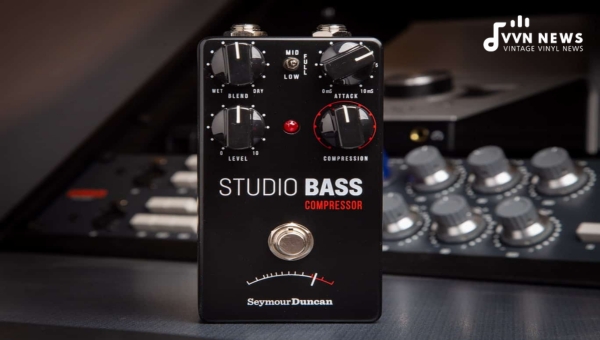
Mastering the effective use of bass compression requires a clear understanding of its key components – the threshold, ratio, attack, release, and knee.
The right tweaking in these areas can differentiate between a muddy mix and a perfect track.
Also Read: How To Transpose Bass Clef To Treble Clef [A How-To Guide]
Determining Compression Threshold
The threshold is the point at which your compressor begins to work. Compression starts kicking in as soon as the signal level crosses this set point.
If you want a more natural sound, you’d aim to set your threshold higher so it only compresses when the bass is playing super loud.
You would choose a lower threshold for a denser sound where nearly all notes are compressed equally.
A side note here – every mix is unique, and there’s no one-size-fits-all threshold setting.
Setting Compression Ratio
Next up is adjusting your compression ratio—another integral aspect of using bass compression effectively.
The ratio determines how much compression will be applied once the input signal exceeds the threshold level.
A low ratio (e.g., 2:1) means a softer compression effect marked by subtle volume reduction, whereas higher ratios (e.g., 10:1) translate into heavy squashing or limiting of levels beyond the threshold.
There’s no rulebook! Feel free to play around with different ratios based on your desired effect and musical style.
Adjusting Compression Attack
Compression attack is another critical area that requires just as much attention during mixdowns. It’s the time taken for a compressor to fully kick in after an incoming signal goes past your set threshold.
Regarding bass compression, an ultrafast attack time controls peaks efficiently but risks robbing your sound of dynamic expression and impact.
In contrast, slow attack times preserve punchiness but may fail to adequately rein in aggressive transient peaks.
Modifying Compression Release
Release time substantially influences how your compressed audio feels rhythmically and tonally.
It denotes how quickly a compressor stops working after the sound falls below your designated threshold level setting—too fast can cause unnatural “pumping” effects.
At the same time, too slow prolongs into nearby notes, causing a smooth but potentially squashed sound impression!
Differentiating between Hard-Knee and Soft-Knee Compression
Understanding whether hard-knee or soft-knee compression can make or break a mix!
A ‘hard knee’ means that once your input crosses over that designated magic line (your threshold), full compression kicks in instantly – producing assertive control over dynamics but sometimes leading towards perceptibly abrupt volume drops!
On the other hand, ‘soft knee’ gently eases into full-on compress mode only when we drift significantly over said magical line – generating smoother transitions along with less ‘strict sounding’ dynamic control!
Both have pros-cons, so it’s all about which serves YOUR music purpose best!
Well, there we have it! Diving into these settings could seem technical at first glance.
Still, once you start navigating this fascinating road of bass compression settings – we assure you that it opens up new arenas of creative possibilities and offers exceptionally fine-tuned control that music producers crave.
Also Read: Bass Clef [Understanding This Essential Music Symbol]
Issues Encountered During Bass Compression
Despite its undeniable benefits, applying bass compression is not without its challenges.
Ignoring these issues may lead to a poorly mixed track that neither sounds good nor communicates the musical intent effectively.
Here are some common problems that can arise during bass compression:
Lack of Subwoofer & Poor Acoustic Surroundings
Not having a subwoofer could significantly limit your ability to monitor low frequencies efficiently.
This becomes particularly problematic when applying bass compression, as accurate monitoring is critical.
You must hear the lows clearly to make informed decisions on threshold levels, attack times, and release settings.
A poor acoustic environment can lead to a muddied perception of the lower frequencies.
These factors can falsely sway your judgment when setting up your compressor’s parameters, leading to an overcompressed or undercompressed mix.
Overuse of Compression Application
One of the most common pitfalls during mixing is over-compressing your track. Compression is quite powerful but should be used judiciously with the understanding that less is more.
Excessive use could result in an all-too-flat and lifeless sound profile that lacks dynamic variation and naturalness.
Even if you aim for a ‘punchy’ or clean bass tone, avoid leaning too heavily on compression application, as it often results in reduced transient detail and an absence of essential rhythmic bounce.
Isolating and Mixing Bass
Incorporating multiple elements into a mix introduces another layer of complexity when compressing your bass tracks.
It’s tricky isolating the bass from other instruments due to frequency overlap.
When numerous instruments chatter in the same frequency space, they clash or mask each other – creating an awful mix littered with sonic collisions between elements that complement one another instead of competing.
An efficient technique to avoid this masking effect involves carving out specific frequencies for each instrument by equalization before applying compression.
Adopting an Extremely Quick Attack Time
Rapid attack times might seem enticing at first glance; after all, they hold promise for total control over dynamics and better shape-forming capability.
Ultra-fast attack settings can dramatically alter our perception of initial transient detail in our audio source, suppressing the parts that help our brain identify what instrument we hear.
Ultimately, this robs our music of its organic feel and liveliness – rendering an artificial sound devoid of character or warmth.
While these listed complications might seem intimidating at first glance, they needn’t deter you from employing bass compression effectively.
Understanding these challenges is half the battle won; knowing how they affect your mix can guide you toward creating higher-quality tracks whenever you sit at your mixing desk.
Also Read: Mixing Bass And Kick For Low-end Balance [Expert Guide]
Advanced Tips for Better Bass Compression
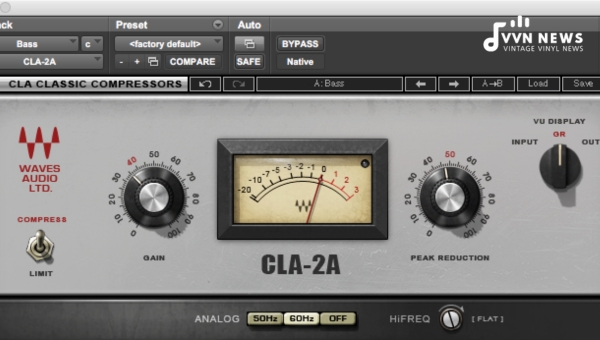
If you want to level up your bass compression game, some advanced tips and techniques are worth exploring.
These methods of parallel processing and multiband compression can offer added nuances to your bass dynamics, further enriching your audio tracks.
Parallel Processing
Parallel processing, also known as New York compression, is a powerful method to keep the original bass’s dynamism while incorporating the compressed sound’s energy.
It involves blending a dry or non-processed signal with a wet or processed one to achieve a balanced yet vibrant output.
Here are some simple steps:
- Duplicate the track onto another channel.
- Apply extensive compression on this duplicated channel.
- Mix the original and compressed media until you achieve the desired sound.
By applying this, you can maintain the natural performance dynamics of the raw bass track while taking advantage of the consistency offered by the heavily compressed version.
Multiband Compression
A step ahead in sophistication is multiband compression. This advanced tool divides your input signal into different frequency bands (similar to equalization), allowing you to apply different contraction intensities on each band.
Steps include:
- Determine which frequency bands need precision control.
- Set different thresholds, ratios, attacks, and releases for every round.
- Balance each round until satisfying results are obtained.
Using this method gives you more control over specific frequencies being problematical without unnaturally suppressing other areas of your bass spectrum.
Understanding and implementing these methods can considerably uplift your audio mixing skills, providing an array of audio textures that enhance the listening experience.
Top-rated Bass Compressor Plugins
The market is flooded with various bass compressor plugins – each with unique features.
This section will cut through the noise and focus on the top five options that genuinely stand out.
MXR M87 Bass Compressor
The MXR M87 is a major player in the arena of bass compressor pedals. It provides exemplary control over sound dynamics with its five knobs that regulate input, output, release, attack, and ratio.
It Handles both active and passive basses proficiently and delivers a transparent sound that effectively lets your original tone shine through.
Key Features:
- 10 LEDs display for monitoring gain reduction
- True bypass switching
- Compact and durable design
- CHT (Constant Headroom Technology) for high headroom performance.
Also Read: 15 Bass Programming Tips For MIDI & Synths [Step Up Your Beat]
Markbass Compressore
Markbass Compressore underlines flexibility and comprehensive control in one sturdy package.
Its tube-based circuitry offers natural warmth to the sound coupled with an extensive array of compressing options via its fine-tuned controls.
Key Features:
- Tube-driven compression gives authentic vintage warmth.
- Versatile controls include gain, ratio, threshold, attack, and release – enabling precise settings.
- Precise VU meter to monitor input or output level or amount of compression.
Boss LMB-3 Bass Limiter/Enhancer
Boss LMB-3 stands as a terrific bargain buy among bass compressors while not compromising on delivering top-tier sound optimization.
It is excellent for achieving even dynamics across performances without muddying your signal.
With simple controls, an enhanced knob that boosts low-end frequencies and cutoff to tame unwanted peaks, coupled with stellar BOSS built quality, makes it an attractive choice for beginners.
Key Features:
- Easy-to-use interface ideal for beginners
- Provides consistent dynamics across different playing styles
- Sturdy built quality typical of Boss products
Aguilar TLC Bass Compressor
Aguilar TLC boasts effectual tonal versatility packed into the aesthetically pleasing casing.
It grants flexible, dynamic control over your playing while preserving the natural voicing of the instrument.
Key Features:
- Provides smooth articulation even in extreme settings
- A broad range of sustain control
- The threshold range extends from -10 dBu to +10 dBu, making it suited for active/passive configurations.
Empress Compressor
The Empress Compressor considers every conceivable need a musician might have from their compressor pedal, earning its spot in the cream-of-the-crop list.
From transparent soft-knee compression to hard-limiting brick wall settings – it can cover them all with optimal tonal clarity.
Key Features:
- Dual compression modes featuring hi-fi specs up to 0 dB.
- Attack/Release/Ratio settings are highly adjustable
- Accurate LED-metering displays gain reduction levels in real time
This guide should get you started on finding your fit among our top picks for bass compressor plugins.
Remember, like every aspect of music production, it essentially boils down to personal preference– so don’t be shy about testing various options until you find your perfect match.
Also Read: Transpose Bari Sax To Bass Clarinet [A Step-By-Step Guide]
FAQs About Bass Compression
Why is Bass Compression important in music production?
Bass compression provides the much-needed balance between loud and quiet sounds, thereby ensuring a consistent, harmonious output.
Can over-application of bass compression lead to issues?
Yes, excessive bass compression can result in a flat and lifeless sound. It’s like seasoning – a dash enhances the flavor, but overuse can spoil the dish.
What is parallel processing in terms of bass compression?
Parallel processing means running the same audio signal through two paths – dry (unprocessed) and wet (processed). This technique brings more punch and dynamic depth to your mix.
Is using a bass compressor plugin essential for bass compression?
While it’s not mandatory, using a reliable bass compressor plugin can simplify the process of achieving an evenly balanced sound output.
How is multiband compression different from regular compression?
Multiband compression allows you to selectively compress different frequency bands, thus providing greater control over your mix.
Conclusion
With a solid understanding of how bass compression works, you can create more balanced and rhythmically consistent tracks in no time.
Remember, every track calls for a unique approach to compression, as there is no ‘one-size-fits-all’ approach.
Emphasize listening carefully and adjusting your settings accordingly – intuitiveness is critical here.
And remember, while bass compression is an incredible tool at your disposal, overuse can lead to a flattened sound and loss of dynamics. Although powerful, always consider it one part of the more excellent sonic picture.
